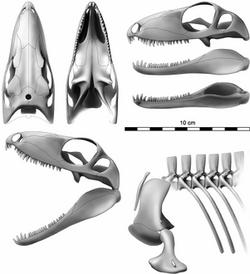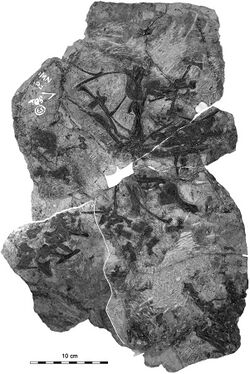Biology:Ianthodon
| Ianthodon | |
|---|---|

| |
| I. schultzei cranial and skeletal reconstruction | |
| Scientific classification | |
| Domain: | Eukaryota |
| Kingdom: | Animalia |
| Phylum: | Chordata |
| Clade: | Synapsida |
| Clade: | Eupelycosauria |
| Clade: | Metopophora |
| Clade: | Haptodontiformes |
| Genus: | †Ianthodon Kissel & Reisz, 2004 |
| Type species | |
| †Ianthodon schultzei Kissel & Reisz, 2004
| |
Ianthodon is an extinct genus of basal haptodontiform synapsids from the Late Carboniferous about 304 million years ago. The taxon was discovered and named by Kissel & Reisz in 2004.[1] The only species in the taxon, Ianthodon schultzei, was found by separating it from a block that also contained the remains of Petrolacosaurus and Haptodus. The evolutionary significance of the taxon wasn't realized until a publication in 2015.[2] The fossil of this organism was discovered in Garnett, Kansas.[2]
Description
Ianthodon was first named by Kissel & Reisz in 2004,[1] and a more detailed specimen was reevaluated in 2014.[2] This single juvenile skeleton with delicate bones has an estimated skull length of around 10 cm, which is similar to other taxa, such as Haptodus,[3] during the same development stage.[1][4] The specimen was easily distinguished from the skeletal element of Petrolacosaurus[5] by the position and the proportion of foreman and supinator process in the humeri.
Skull
Ianthodon was identified as the basalmost known sphenacodont.[2] It can be distinguished from Haptodus[6][3] by its narrower skull and dentition. The higher number of precaninie maxillary teeth and the more rectangular shape of the humerus distinguish the holotype of H. garnettensis[5] from that of Ianthodon. The teeth of Ianthodon have wide bases but slender crowns, unusual among contemporary amniotes and indicating that Ianthodon occupied a different trophic niche from the bulbous-crowned Haptodus to which it was closely related.[6] Like other sphenacodonts, Ianthodon has a tall lacrimal bone, and so would have had a proportionally taller snout than more basal synapsids such as varanopids and eothyridids.[7][2]
Classification
Ianthodon belongs to the clade Sphenodontia within the clade Sphenacomorpha. It played an important role in understanding the initial evolution of sphenacodonts.[3] It also provided important evidence of the mammal origin.[8] The cladogram below follows a cladistic analysis by Spindler and colleagues, 2014.[2]
| |||||||||||||||||||||||||||||||||||||||||||||||||||||||||||||
Paleobiology and evolutionary significance
The clear morphological evidence of the new material initialize the finalization of the understanding of the radiation of the Sphenacomorpha,[9] and the evolution of that led to the emergence of mammal.[8] So based on the information, it was concluded that basal Sphenacomorphs came from a generalist form with a great potential for adaptions.[2] However, the understanding of Ianthodon and basal Sphenacodonts are still relatively limited by the number of the specimen available for study and further excavation of Garnett fauna is required, despite the present evidence suggests that Ianthodon represents the primitive condition of sphenacodont evolution,[10] more studies are require for a better understanding of this particular stage of synapids evolution.
See also
- List of pelycosaurs
- List of therapsids
References
- ↑ Jump up to: 1.0 1.1 1.2 Kissel, R. A. & Reisz, R. R. Synapsid fauna of the Upper Pennsylvanian Rock Lake Shale near Garnett, Kansas and the diversity pattern of early amniotes. In G. Arratia, M. V. H. Wilson & R. Cloutier (eds.). Recent Advances in the Origin and Early Radiation of Vertebrates. Verlag Dr. Friedrich Pfeil, 2004.
- ↑ Jump up to: 2.0 2.1 2.2 2.3 2.4 2.5 2.6 Spindler, F.; Scott, Diane; Reisz, Robert (October 2014). "New information on the cranial and postcranial anatomy of the early synapsid Ianthodon schultzei (Sphenacomorpha: Sphenacodontia), and its evolutionary significance". Fossil Record 18: 17-30. https://www.researchgate.net/publication/280961968.
- ↑ Jump up to: 3.0 3.1 3.2 Currie, P. J.: A new haptodontine sphenacodont (Reptilia: Pelycosauria) from the Upper Pennsylvanian of North America, J. Paleontol., 51, 927–942, 1977
- ↑ Reisz, Robert R.; Heaton, Malcolm J.; Pynn, Bruce R. (1982). "Vertebrate Fauna of Late Pennsylvanian Rock Lake Shale near Garnett, Kansas: Pelycosauria". Journal of Paleontology 56 (3): 741–750.
- ↑ Jump up to: 5.0 5.1 Roger B. J. Benson (2012) Interrelationships of basal synapsids: cranial and postcranial morphological partitions suggest different topologies, Journal of Systematic Palaeontology, 10:4, 601-624, DOI: 10.1080/14772019.2011.631042
- ↑ Jump up to: 6.0 6.1 Laurin, Michel (1993). "Anatomy and Relationships of Haptodus garnettensis, a Pennsylvanian Synapsid from Kansas". Journal of Vertebrate Paleontology 13 (2): 200–229. doi:10.1080/02724634.1993.10011501.
- ↑ Fröbisch, Jörg; Schoch, Rainer R.; Müller, Johannes; Schindler, Thomas; Schweiss, Dieter (March 2011). "A New Basal Sphenacodontid Synapsid from the Late Carboniferous of the Saar-Nahe Basin, Germany". Acta Palaeontologica Polonica 56 (1): 113–120. doi:10.4202/app.2010.0039. ISSN 0567-7920.
- ↑ Jump up to: 8.0 8.1 Kemp, T. S.: Mammal-like Reptiles and the Origin of Mammals, Academic Press, New York, 1982
- ↑ Osborn, H. F.: The reptilian subclasses Diapsida and Synapsida and the early history of the Diaptosauria, Memoirs of the American Museum of Natural History, 1, 449–507, 1903
- ↑ Reisz, R. R., Berman, D. S., and Scott, D.: The cranial anatomy and relationships of Secodontosaurus, an unusual mammal-like reptile (Synapsida: Sphenacodontidae) from the early Permian of Texas, Zool. J. Linn. Soc.-Lond., 104, 127–184, 1992
Wikidata ☰ Q60373 entry
 |


